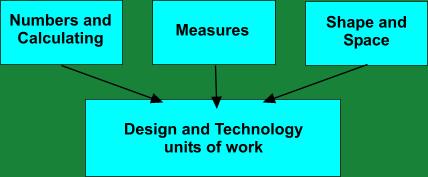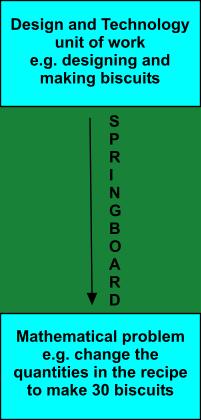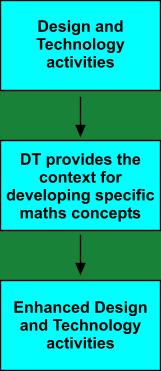 |
|
 |
For accessibility information on this site use accesskey "0"
Skip Navigation and go straight to the main content or use use accesskey "s"
 |
|
 |
| Introduction | |
| Why link DT with Mathematics? | |
| What are the implications for long term planning? | |
| What are the effects of different grouping arrangements? |
This Guideline has two main purposes. First, it encourages schools to take advantage of existing links between design and technology and mathematics. Second, it offers practical suggestions for establishing new links through long, medium and short-term planning. The aim, in due course, is to illustrate the Guideline with examples of good practice using the National Association of Advisers and Inspectors in Design and Technology (NAAIDT) web site www.naaidt.org.uk
Although the Guideline has a particular focus on the Framework for Teaching Mathematics, the underlying principles for linking design and technology with mathematics are applicable to all primary schools in England, Wales and Northern Ireland
This guidance builds on the NAAIDT Guideline - Bringing Literacy to Life. Whilst many of the principles for making links with literacy are repeated in this Guideline, there are some important differences.
On balance, pupils' learning in literacy gains more than their learning in design and technology from links between the two subjects. In contrast, making links between design and technology and mathematics has significant benefits for learning in both subjects. Units of work in design and technology provide genuine and meaningful opportunities for pupils to develop and apply their mathematical understanding. Likewise, mathematics activities develop a range of essential concepts that underpin pupils' achievement and success in design and technology.
Since September 1999, primary schools have worked hard to deliver the National Numeracy Strategy through sharply focused daily mathematics lessons. However, the revised National Curriculum re-affirms the importance of identifying helpful connections between subjects with 'key links' identified in the programmes of study for all subjects. The intention is to show how learning in one subject can build upon learning in another. This approach can increase manageability across the curriculum whilst enhancing the quality of teaching and learning.
Raising standards in mathematics and design and technology
There are many examples in primary schools of real-life maths problems based on design and technology. The following example, from the Framework for Teaching Mathematics, illustrates how pupils could develop and apply mathematical operations and methods of calculation:
Gwen has a box of 250 staples to make kites.
She uses 16 staples to make each kite.
How many complete kites can she make?
(p.83, Supplement of Examples for Y4, 5, 6)
However, from a design and technology perspective, there is no obvious reason for solving the problem. The number of kites to be made is far more likely to be determined by needs of the user than by the quantity of available staples. Whilst the problem aims to develop mathematical understanding, it serves no practical purpose. Similarly, it is difficult to imagine a real-life situation that would require a solution for the following problem:
Ravi bought a pack of 30 biscuits.
He ate one fifth of them on Thursday.
He ate one eighth of the remaining biscuits on Friday.
How many biscuits did he have left?
(p.87, Supplement of Examples for Y4, 5, 6)
In contrast, design and technology activities provide a real and purposeful context for the application of mathematics. Pupils are highly motivated and make good progress when tackling mathematical problems directly related to the design and technology unit they are undertaking. In fact, the Framework for Teaching Mathematics acknowledges that it is 'important to find time in other subjects for pupils to develop and apply their mathematical skills' (p.11).
The establishment of links also makes a significant impact on the standards achieved in design and technology. All units of work in design and technology require the application of mathematics to a greater or lesser extent. However, the success of some units relies heavily upon the application of specific mathematical concepts. In these circumstances the identification and teaching of the necessary concepts prior to the relevant design and technology activities has a direct bearing on pupils' achievement in design and technology.
Meeting the requirements of the revised National Curriculum
Existing units of work in design and technology draw frequently upon pupils' mathematical understanding. There are so many ongoing applications of this type that it is not possible on each occasion to make a formal link at the planning stage. However, it is important to check that the mathematical demands of each design and technology unit are consistent with the average age and ability of the pupils undertaking them. It is also important to take account of individual pupils' prior learning in mathematics so that necessary additional support can be given.

Ongoing mathematical applications are well documented. For example, guidance with the revised National Curriculum for Design and Technology suggests that the measuring and marking out of materials should build upon pupils understanding of measures. At key stages 1 and 2, pupils regularly need to apply their understanding of non-standard and standard measures, for example length, when making products as well as using estimation, ordering and comparison. More detailed reference is made in the DfEE/QCA Scheme of Work for Design and Technology to the application of measures in units of work on food, textiles, structures and mechanisms
The DfEE/QCA Scheme also refers to the application of numbers and calculating. Pupils have ongoing opportunities to apply their understanding of number when calculating the quantities or cost of materials and components needed in the product they are making.
For younger pupils this entails counting and simple addition and subtraction, whilst older pupils will apply understanding of percentage, proportion and fractions.
Pupils' understanding of shape and space is applied when they are describing the position of various components, the direction of movement in a mechanical product, the shapes and angles to be incorporated into a structure or the pattern pieces used in a textiles product.
Planned links where design and technology units provide the 'springboard' for maths activities
| There are occasions where work undertaken in design and technology can provide an interesting starting point or 'springboard' for activities during a mathematics lesson. For example, when pupils have completed a unit on designing and making biscuits the following problem could be given - how could the quantities in the recipe could be changed to make X biscuits? |  |
| Although the mathematics undertaken may not feedback into subsequent work in design and technology, pupils see the relevance in solving problems that are directly connected to their practical experience. This type of link needs careful medium and short-term planning to ensure that the mathematics work closely follows the design and technology lesson in order to capitalise on pupils' enthusiasm and motivation. |
Planned links where design and technology units require specific maths concepts to be developed
| A range of design and technology units of work depend, at some stage, upon the development of specific mathematical concepts for their successful completion. |  |
| This type of link provides a genuine context for mathematics as well as raising standards in many aspects of design and technology: |
Again, careful termly and weekly planning is required to ensure that the design and technology activities dovetail with the relevant aspect of mathematics, for example:
Where schools timetable a flexible half-hour session during the course of the morning this helps to create a more seamless link between design and technology and mathematics. In these circumstances pupils could, for example, spend time carrying out sensory evaluation immediately prior to a maths lesson focusing on data handling. The advantage of this arrangement is that the pupils have the knowledge and understanding gained from design and technology fresh in their minds.
In addition, it is important to maximise the relevance of the links between design and technology and mathematics and make these explicit to pupils. For instance, it is more effective for pupils to explore gear ratios when the context of their designing and making has previously been established and if they know that this experience will be helpful when they make their electrically controlled vehicles
To fully exploit links between design and technology and mathematics a certain amount of flexibility is required in long-term planning.
Where the success of a unit of work in design and technology is largely dependent on the application of particular mathematical concepts - for example when pupils are designing and making packaging - schools may wish to move the unit so that it is located in the term when the concepts are scheduled to be taught.
However, schools who are following the planning grids in the Framework for Teaching Mathematics may wish to redistribute some of the objectives within each year group so that effective links with design and technology can be established.
Building on previous experience
In circumstances where pupils are taught in the same group for design and technology and mathematics, teachers can use their knowledge of what was covered in design and technology lessons to set up the context for work in mathematics. They are also well placed to use their assessments of pupils' attainment and progress in design and technology to inform the pitch of their questioning during the daily mathematics lesson.
Setting for mathematics
Careful consideration is required where pupils are set by ability for mathematics because the teacher taking pupils for their daily maths lesson may not necessarily be the same one who teaches them design and technology
In these circumstances it is particularly important for teachers who teach the same year group(s) to plan collaboratively so that links between the two subjects can be established. However, collaborative planning cannot in itself provide the in-depth knowledge about pupil capabilities in design and technology that is so useful when links with mathematics are being established.
Useful publications
All NAAIDT publications are available from DATA, at the address below.
Please send any comments on this Guideline to: Guideline@naaidt.org.uk
For a list of other NAAIDT publications see the Publications section or send s.a.e. to:
DATA, 16 Wellesbourne Road, Wellesbourne, Warwickshire CV35 9JB.
For more information on the work of the Association contact: Hon.Sec@naaidt.org.uk
This Guideline was presented in draft form by Gareth Pimley at the Design and Technology International Millennium Conference.
© NAAIDT 07/00